 W
WPrehistoric Wales in terms of human settlements covers the period from about 230,000 years ago, the date attributed to the earliest human remains found in what is now Wales, to the year AD 48 when the Roman army began a military campaign against one of the Welsh tribes. Traditionally, historians have believed that successive waves of immigrants brought different cultures into the area, largely replacing the previous inhabitants, with the last wave of immigrants being the Celts. However, studies of population genetics now suggest that this may not be true, and that immigration was on a smaller scale.
 W
WA bank barrow, sometimes referred to as a barrow-bank, ridge barrow, or ridge mound, is a type of tumulus first identified by O.G.S. Crawford in 1938.
 W
WA bowl barrow is a type of burial mound or tumulus. A barrow is a mound of earth used to cover a tomb. The bowl barrow gets its name from its resemblance to an upturned bowl. Related terms include cairn circle, cairn ring, howe, kerb cairn, tump and rotunda grave.
 W
WCefn Bryn is an ancient ridge in Britain. It is a 5-mile-long Old Red Sandstone ridge in south Wales, in the heart of the Gower Peninsula, in the City and County of Swansea. Local people colloquially refer to it as the "backbone of Gower", as it protrudes from surrounding limestone. The highest point on the ridge is the second highest point in the peninsula, offering panoramic views of the surrounding country and seas. The swathes of grassland around the ridge are known as Cefn Bryn Common.
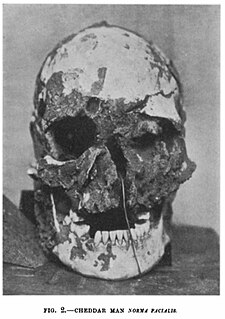 W
WCheddar Man is a human male fossil found in Gough's Cave in Cheddar Gorge, Somerset, England. The skeletal remains date to the Mesolithic and it appears that he died a violent death. A large crater-like lesion just above the skull's right orbit suggests that the man may have also been suffering from a bone infection.
 W
WThe Creswellian is a British Upper Palaeolithic culture named after the type site of Creswell Crags in Derbyshire by Dorothy Garrod in 1926. It is also known as the British Late Magdalenian. According to Andreas Maier: "In current research, the Creswellian and Hamburgian are considered to be independent but closely related entities which are rooted in the Magdalenian." The Creswellian is dated between 13,000–11,800 BP and was followed by the most recent ice age, the Younger Dryas, when Britain was at times unoccupied by humans.
 W
WThe Cromer Forest Bed is a geological formation in Norfolk, England. It consists of river gravels, estuary and floodplain sediments predominantly clays and muds as well as sands along the coast of northern Norfolk. It is the type locality for the Cromerian Stage of the Pleistocene between 0.8 and 0.5 million years ago., The deposit itself range varies in age from about 2 to 0.5 million years ago. It is about 6 metres thick and is exposed in cliff section near the town of West Runton. For over a century the bed, named after the local town of Cromer, has been famous for its assemblage of fossil mammal remains, containing the diverse remains of numerous taxa, including deer, carnivorans and birds. Although most of the forest bed is now obscured by coastal defence, the Cromer Forest Bed continues to be eroded and is rich in fossils including the skeletal remains of the West Runton Mammoth which was discovered in 1990. The oldest human footprints outside Africa, the Happisburgh footprints as well as handaxes and bison bones with cut marks were also found in layers considered to belong to this deposit near the town of Happisburgh.
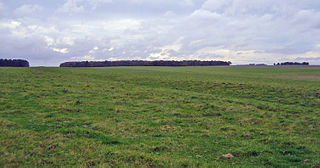 W
WCursus monuments are Neolithic structures which represent some of the oldest prehistoric monumental structures of the Islands of Britain and Ireland. Relics found within them show that they were built between 3400 and 3000 BC.
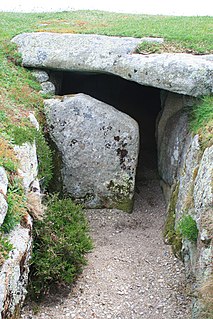 W
WEntrance grave is a type of Neolithic and early Bronze Age chamber tomb found primarily in Great Britain. The burial monument typically consisted of a circular mound bordered by a stone curb, erected over a rectangular burial chamber and accessed by a narrow, stone lined entrance. Entrance graves have been discovered in the Isles of Scilly, west Cornwall, southeast Ireland, southwest Scotland, Brittany and the Channel Islands. They are often referred to as the Scillonian' Group, named for the Scillian Islands where the majority of entrance graves have been discovered.
 W
WThe Gray's Inn Lane Hand Axe is a pointed flint hand axe, found buried in gravel under Gray's Inn Lane, London, England, by pioneering archaeologist John Conyers in 1679, and now in the British Museum. The hand axe is a fine example from about 350,000 years ago, in the Lower Paleolithic period, but its main significance lies in the role it and the circumstances of its excavation played in the emerging understanding of early human history.
 W
WGrooved ware is the name given to a pottery style of the British Neolithic. Its manufacturers are sometimes known as the Grooved ware people. Unlike the later Beaker ware, Grooved culture was not an import from the continent but seems to have developed in Orkney, early in the 3rd millennium BC, and was soon adopted in Britain and Ireland.
 W
WThere are three related types of Neolithic earthwork that are all sometimes loosely called henges. The essential characteristic of all three is that they feature a ring-shaped bank and ditch, with the ditch inside the bank. Because the internal ditches would have served defensive purposes poorly, henges are not considered to have been defensive constructions. The three henge types are as follows, with the figure in brackets being the approximate diameter of the central flat area:Henge (> 20 m). The word henge refers to a particular type of earthwork of the Neolithic period, typically consisting of a roughly circular or oval-shaped bank with an internal ditch surrounding a central flat area of more than 20 m (66 ft) in diameter. There is typically little if any evidence of occupation in a henge, although they may contain ritual structures such as stone circles, timber circles and coves. Henge monument is sometimes used as a synonym for henge. Henges sometimes, but by no means always, featured stone or timber circles, and circle henge is sometimes used to describe these structures. The three largest stone circles in Britain are each within a henge. Examples of henges without significant internal monuments are the three henges of Thornborough Henges. Although having given its name to the word henge, Stonehenge is atypical in that the ditch is outside the main earthwork bank. Hengiform monument (5 – 20 m). Like an ordinary henge, except the central flat area is between 5 and 20 m (16–66 ft) in diameter, they comprise a modest earthwork with a fairly wide outer bank. The terms Mini henge or Dorchester henge are sometimes used as synonyms for hengiform monument. An example is the Neolithic site at Wormy Hillock Henge. Henge enclosure (> 300 m). A Neolithic ring earthwork with the ditch inside the bank, with the central flat area having abundant evidence of occupation and usually being more than 300 m (980 ft) in diameter. Some true henges are as large as this, but lack evidence of domestic occupation. Super henge is sometimes used as a synonym for a henge enclosure. However, sometimes Super henge is used to indicate size alone rather than use, e.g. "Marden henge ... is the least understood of the four British 'superhenges' ".
 W
WThere are three related types of Neolithic earthwork that are all sometimes loosely called henges. The essential characteristic of all three is that they feature a ring-shaped bank and ditch, with the ditch inside the bank. Because the internal ditches would have served defensive purposes poorly, henges are not considered to have been defensive constructions. The three henge types are as follows, with the figure in brackets being the approximate diameter of the central flat area:Henge (> 20 m). The word henge refers to a particular type of earthwork of the Neolithic period, typically consisting of a roughly circular or oval-shaped bank with an internal ditch surrounding a central flat area of more than 20 m (66 ft) in diameter. There is typically little if any evidence of occupation in a henge, although they may contain ritual structures such as stone circles, timber circles and coves. Henge monument is sometimes used as a synonym for henge. Henges sometimes, but by no means always, featured stone or timber circles, and circle henge is sometimes used to describe these structures. The three largest stone circles in Britain are each within a henge. Examples of henges without significant internal monuments are the three henges of Thornborough Henges. Although having given its name to the word henge, Stonehenge is atypical in that the ditch is outside the main earthwork bank. Hengiform monument (5 – 20 m). Like an ordinary henge, except the central flat area is between 5 and 20 m (16–66 ft) in diameter, they comprise a modest earthwork with a fairly wide outer bank. The terms Mini henge or Dorchester henge are sometimes used as synonyms for hengiform monument. An example is the Neolithic site at Wormy Hillock Henge. Henge enclosure (> 300 m). A Neolithic ring earthwork with the ditch inside the bank, with the central flat area having abundant evidence of occupation and usually being more than 300 m (980 ft) in diameter. Some true henges are as large as this, but lack evidence of domestic occupation. Super henge is sometimes used as a synonym for a henge enclosure. However, sometimes Super henge is used to indicate size alone rather than use, e.g. "Marden henge ... is the least understood of the four British 'superhenges' ".
 W
WThere are three related types of Neolithic earthwork that are all sometimes loosely called henges. The essential characteristic of all three is that they feature a ring-shaped bank and ditch, with the ditch inside the bank. Because the internal ditches would have served defensive purposes poorly, henges are not considered to have been defensive constructions. The three henge types are as follows, with the figure in brackets being the approximate diameter of the central flat area:Henge (> 20 m). The word henge refers to a particular type of earthwork of the Neolithic period, typically consisting of a roughly circular or oval-shaped bank with an internal ditch surrounding a central flat area of more than 20 m (66 ft) in diameter. There is typically little if any evidence of occupation in a henge, although they may contain ritual structures such as stone circles, timber circles and coves. Henge monument is sometimes used as a synonym for henge. Henges sometimes, but by no means always, featured stone or timber circles, and circle henge is sometimes used to describe these structures. The three largest stone circles in Britain are each within a henge. Examples of henges without significant internal monuments are the three henges of Thornborough Henges. Although having given its name to the word henge, Stonehenge is atypical in that the ditch is outside the main earthwork bank. Hengiform monument (5 – 20 m). Like an ordinary henge, except the central flat area is between 5 and 20 m (16–66 ft) in diameter, they comprise a modest earthwork with a fairly wide outer bank. The terms Mini henge or Dorchester henge are sometimes used as synonyms for hengiform monument. An example is the Neolithic site at Wormy Hillock Henge. Henge enclosure (> 300 m). A Neolithic ring earthwork with the ditch inside the bank, with the central flat area having abundant evidence of occupation and usually being more than 300 m (980 ft) in diameter. Some true henges are as large as this, but lack evidence of domestic occupation. Super henge is sometimes used as a synonym for a henge enclosure. However, sometimes Super henge is used to indicate size alone rather than use, e.g. "Marden henge ... is the least understood of the four British 'superhenges' ".
 W
WThe Icknield Way is an ancient trackway in southern and eastern England that goes from Norfolk to Wiltshire. It follows the chalk escarpment that includes the Berkshire Downs and Chiltern Hills.
 W
WThe Langdale axe industry is the name given by archaeologists to specialised stone tool manufacturing centred at Great Langdale in England's Lake District during the Neolithic period. The existence of a production site was originally suggested by chance discoveries in the 1930s, which were followed by more systematic searching in the 1940s and 1950s by Clare Fell and others. The finds were mainly reject axes, rough-outs and blades created by knapping large lumps of the rock found in the scree or perhaps by simple quarrying or opencast mining. Hammerstones have also been found in the scree and other lithic debitage from the industry such as blades and flakes.
 W
WIn the Neolithic and Bronze Age British Isles, rock art was produced across various parts of the islands. Petroglyphic in nature, the majority of such carvings are abstract in design, usually cup and ring marks, although examples of spirals or figurative depictions of weaponry are also known. Only one form of rock art in Europe, this late prehistoric tradition had connections with others along Atlantic Europe, particularly in Galicia.
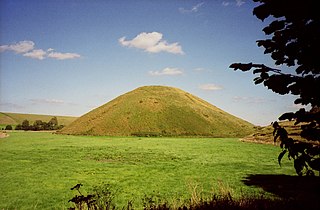 W
WThe Neolithic British Isles refers to the period of British, Irish and Manx history that spanned from circa 4000 to circa 2,500 BCE. The final part of the Stone Age in the British Isles, it was a part of the greater Neolithic, or "New Stone Age", across Europe.
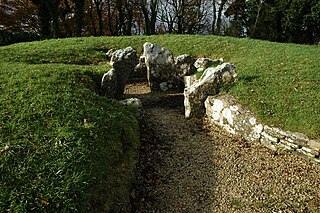 W
WNympsfield Long Barrow is the remains of a Neolithic burial site or barrow, located close to the village of Nympsfield in Gloucestershire, South West England.
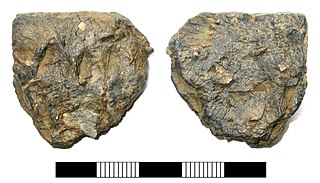 W
WPeterborough ware is a decorated pottery style of the early to middle Neolithic. Named after the region of Middlesex and East Anglia, England where the style was first discovered, it is known for the impressed pits made by bone or wood implements in its sides. Whipped cord was also used to make circular 'maggot' patterns.
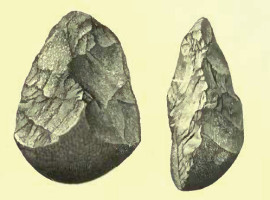 W
WThe Saltley handaxe is a quartzite hand axe found in the gravels of the valley of the River Rea in the Saltley area of Birmingham, England in 1890. Believed to be approximately 500,000 years old, it was the first human artefact from the paleolithic era found in the English Midlands, which had previously been considered not to have been inhabited before the end of the last glacial period.
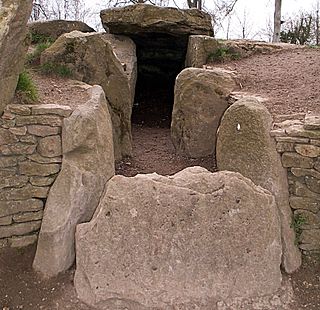 W
WThe Cotswold-Severn Group are a series of long barrows erected in an area of western Britain during the Early Neolithic. Around 200 known examples of long barrows are known from the Cotswold-Severn region, although an unknown number of others were likely destroyed prior to being recorded.